Ceramic Matrix Composites Obtained by the Reactive Sintering of Boron Carbide with Intermetallic Compounds from the Ti-Si System
Abstract
:1. Introduction
2. Thermodynamic Calculations
3. Materials and Methods
3.1. Materials
3.2. Procedures
4. Results
4.1. Characteristics of the Sintering Process
4.2. Density Measurement and Porosity
4.3. Mechanical Properties
4.4. Microstructure Observation
5. Discussion
6. Conclusions
- Due to the presence of a liquid phase from the intermetallic materials, it is possible to lower the synthesis temperature from 2000 °C (currently used when using other precursors) to 1650 °C. During the sintering, the boron carbide stoichiometry converts from B4C to B13C2.
- When TiSi2 was used as an additive, an overall increase in the sintering temperature was observed, excluding the smallest amount of additive. The opposite is true for the addition of Ti5Si3; in this case, the effect is a decrease in the sintering temperature.
- A chemical reaction taking place during the sintering is very effective. Almost 99% of the initial phases decompose and allow the formation of new TiB2 and SiC phases, which are well densified at relatively low temperatures. The TiC phase is formed only when no boron is present in the system during sintering; hence, in the case of the addition of Ti5Si3, when there is a significant amount of Ti in the system and a lack of boron, a small amount of the TiC phase is formed.
- The microstructure and mechanical properties of the B4C–TiB2–SiC ceramic composites can be effectively tuned by regulating the combinations of the composition of the starting precursors used, in particular through the use of various intermetals from the Ti-Si system. In the composites B4C–TiB2–SiC carbon residue is observed in the phase composition, formed during the synthesis in the composites with the use of traditional phase compositions obtained. The presence of carbon in the microstructure significantly reduces its mechanical strength. In the case of using boron carbide and intermetals from the Ti-Si system and the affinity of carbon for silicon, and titanium for boron, there is no carbon left in the system, which weakens the structure of the obtained composites.
- Both additives tend to be characterized by similar hardness values to each other. A higher hardness obtained for the addition of intermetallic TiSi2, in relation to the addition of Ti5Si3 are associated with obtaining a larger amount of the SiC phase, which has a higher hardness than the TiB2 phase. The maximum hardness is obtained in the samples with stochiometric additive content, which are 16.4 GPa for TiSi2 and 11.7 GPa for Ti5Si3, respectively.
7. Patents
Author Contributions
Funding
Institutional Review Board Statement
Informed Consent Statement
Data Availability Statement
Conflicts of Interest
References
- Wang, Y.; Liu, Q.; Zhang, B.; Zhang, H.; Jin, Y.; Zhong, Z.; Ye, J.; Ren, Y.; Ye, F.; Wang, W. Microstructure and Mechanical Behaviour of Transient Liquid Phase Spark Plasma Sintered B4C–SiC–TiB2 Composites from a B4C–TiSi2 System. Ceram. Int. 2021, 47, 10665–10671. [Google Scholar] [CrossRef]
- Wang, Y.J.; Peng, H.X.; Ye, F.; Zhou, Y. Effect of TiB2 Content on Microstructure and Mechanical Properties of In-Situ Fabricated TiB2/B4C Composites. Trans. Nonferrous Met. Soc. China 2011, 21, s369–s373. [Google Scholar] [CrossRef] [Green Version]
- Zhou, Y.; Sun, Z.; Chen, S.; Zhang, Y. In-Situ Hot Pressing/Solid-Liquid Reaction Synthesis of Dense Titanium Silicon Carbide Bulk Ceramics. Mater. Res. Innov. 1998, 2, 142–146. [Google Scholar] [CrossRef]
- Neuman, E.W.; Hilmas, G.E.; Fahrenholtz, W.G. Pressureless Sintering of Zirconium Diboride with Carbon and Boron Carbide Nanopowder. Ceram. Int. 2022, 48, 13071–13079. [Google Scholar] [CrossRef]
- Wypych, G. 2-Fillers—Origin, Chemical Composition, Properties, and Morphology. In Handbook of Fillers, 5th ed.; Chemtec Publishing: Scarborough, ON, Canada, 2021; pp. 13–302. [Google Scholar]
- Wang, S.; Li, L.; Yan, S.; Deng, Y.; Gao, S.; Xing, P. Preparing B4C-SiC-TiB2 Composites via Reactive Pressureless Sintering with B4C and TiSi2 as Raw Materials. J. Mater. Res. Technol. 2020, 9, 8685–8696. [Google Scholar] [CrossRef]
- Saeedi Heydari, M.; Baharvandi, H.R. Effect of Different Additives on the Sintering Ability and the Properties of B4C-TiB2 Composites. Int. J. Refract. Met. Hard Mater. 2015, 51, 61–69. [Google Scholar] [CrossRef]
- Xu, C.; Cai, Y.; Flodström, K.; Li, Z.; Esmaeilzadeh, S.; Zhang, G.J. Spark Plasma Sintering of B4C Ceramics: The Effects of Milling Medium and TiB2 Addition. Int. J. Refract. Met. Hard Mater. 2012, 30, 139–144. [Google Scholar] [CrossRef]
- White, R.M.; Dickey, E.C. Mechanical Properties and Deformation Mechanisms of B4C-TiB2 Eutectic Composites. J. Eur. Ceram. Soc. 2014, 34, 2043–2050. [Google Scholar] [CrossRef]
- Suri, A.K.; Subramanian, C.; Sonber, J.K.; Ch Murthy, T.S.R. Synthesis and Consolidation of Boron Carbide: A Review. Int. Mater. Rev. 2010, 55, 4–40. [Google Scholar] [CrossRef]
- Ojalvo, C.; Zamora, V.; Moreno, R.; Guiberteau, F.; Ortiz, A.L. Transient Liquid-Phase Assisted Spark-Plasma Sintering and Dry Sliding Wear of B4C Ceramics Fabricated from B4C Nanopowders. J. Eur. Ceram. Soc. 2021, 41, 1869–1877. [Google Scholar] [CrossRef]
- Zhong, Z.; Yang, A.; Wang, R.; Wen, Q.; Zhu, Z.; Wang, G.; Zhang, H. On the Use of TiSi Eutectic Alloy as a Novel Sintering Aid for B4CTiB2SiC Ceramic Composites. Ceram. Int. 2019, 45, 12393–12398. [Google Scholar] [CrossRef]
- Fahrenholtz, W.G.; Hilmas, G.E.; Zhang, S.C.; Zhu, S. Pressureless Sintering of Zirconium Diboride: Particle Size and Additive Effects. J. Am. Ceram. Soc. 2008, 91, 1398–1404. [Google Scholar] [CrossRef]
- Ojalvo, C.; Sánchez-González, E.; Guiberteau, F.; Borrero-López, O.; Ortiz, A.L. Improving the Dry Sliding-Wear Resistance of B4C Ceramics by Transient Liquid-Phase Sintering. J. Eur. Ceram. Soc. 2020, 40, 5286–5292. [Google Scholar] [CrossRef]
- Ortiz, A.L.; Galán, C.A.; Borrero-López, O.; Guiberteau, F. Highly Sliding-Wear Resistant B4C Composites Fabricated by Spark-Plasma Sintering with Ti–Al Additives. Scr. Mater. 2020, 177, 91–95. [Google Scholar] [CrossRef]
- Ji, W.; Todd, R.I.; Wang, W.; Wang, H.; Zhang, J.; Fu, Z. Transient Liquid Phase Spark Plasma Sintering of B4C-Based Ceramics Using Ti-Al Intermetallics as Sintering Aid. J. Eur. Ceram. Soc. 2016, 36, 2419–2426. [Google Scholar] [CrossRef]
- Ojalvo, C.; Guiberteau, F.; Ortiz, A.L. Fabricating Toughened Super-Hard B4C Composites at Lower Temperature by Transient Liquid-Phase Assisted Spark Plasma Sintering with MoSi2 Additives. J. Eur. Ceram. Soc. 2019, 39, 2862–2873. [Google Scholar] [CrossRef]
- Akhtar, S.S. A Critical Review on Self-Lubricating Ceramic-Composite Cutting Tools. Ceram. Int. 2021, 47, 20745–20767. [Google Scholar] [CrossRef]
- Grigoriev, S.N.; Gurin, V.D.; Volosova, M.A.; Cherkasova, N.Y. Development of Residual Cutting Tool Life Prediction Algorithm by Processing on CNC Machine Tool. Mater. Werkst. 2013, 44, 790–796. [Google Scholar] [CrossRef]
- Kuzin, V.V.; Grigoriev, S.N.; Volosova, M.A. The Role of the Thermal Factor in the Wear Mechanism of Ceramic Tools: Part 1. Macrolevel. J. Frict. Wear 2014, 35, 505–510. [Google Scholar] [CrossRef]
- Grigoriev, S.N.; Pristinskiy, Y.; Soe, T.N.; Malakhinsky, A.; Mosyanov, M.; Podrabinnik, P.; Smirnov, A.; Pinargote, N.W.S. Processing and Characterization of Spark Plasma Sintered SiC-TiB2-TiC Powders. Materials 2022, 15, 1946. [Google Scholar] [CrossRef]
- Zhang, X.; Zhang, Z.; Liu, Y.; Wang, A.; Tian, S.; Wang, W.; Wang, J. High-Performance B4C–TiB2 –SiC Composites with Tuneable Properties Fabricated by Reactive Hot Pressing. J. Eur. Ceram. Soc. 2019, 39, 2995–3002. [Google Scholar] [CrossRef]
- Tishkevich, D.I.; Zubar, T.I.; Zhaludkevich, A.L.; Razanau, I.U.; Vershinina, T.N.; Bondaruk, A.A.; Zheleznova, E.K.; Dong, M.; Hanfi, M.Y.; Sayyed, M.I.; et al. Isostatic Hot Pressed W–Cu Composites with Nanosized Grain Boundaries: Microstructure, Structure and Radiation Shielding Efficiency against Gamma Rays. Nanomaterials 2022, 12, 1642. [Google Scholar] [CrossRef]
- Williams, J.J. Structure and High-Temperature Properties of Ti5Si3 with Interstitial Additions. Ph.D. Thesis, Iowa State University, Ames, IA, USA, 1999. [Google Scholar]
- Kematick, R.J.; Myers, C.E. Thermodynamics of the Phase Formation of the Titanium Silicides. Chem. Mater. 1996, 8, 287–291. [Google Scholar] [CrossRef]
- Topor, L.; Kleppa, O.J. Standard Enthalpies of Formation of TiSi2 and VSi2 by High-Temperature Calorimetry. Met. Mater. Trans. A 1986, 17, 1217–1221. [Google Scholar] [CrossRef]
- Rzepa, S.; Chlubny, L.; Bucki, T. The Ti-Si Intermetallic Phases Synthesis by SHS Method. In Proceedings of the 27th International Conference on Metallurgy and Materials, Brno, Czech Republic, 23–25 May 2018; pp. 1699–1704. [Google Scholar]
- Kozień, D.; Pędzich, Z.; Chlubny, L. Sposób Otrzymywania Kompozytu Wysokoogniotrwałego z Węglika Boru i Związku Międzymetalicznego z Układu Ti-Si. The Method of Obtaining Composite Highly Refractory Made of Boron Carbide and An Intermetallic Compound from the Ti-Si System. 2021. Available online: https://ewyszukiwarka.pue.uprp.gov.pl/search/search-results/adbb0038-24b2-4dfc-b895-a00874c08f56 (accessed on 23 October 2022).
- Murthy, S.R. Elastic Properties of Boron Carbide. J. Mater. Sci. Lett. 1985, 4, 603–605. [Google Scholar] [CrossRef]
- Gubernat, A.; Pichór, W.; Zientara, D.; Bućko, M.M.; Zych, Ł.; Kozień, D. Direct Synthesis of Fine Boron Carbide Powders Using Expanded Graphite. Ceram. Int. 2019, 45, 22104–22109. [Google Scholar] [CrossRef]
- Lee, H.; Speyer, R.F. Hardness and Fracture Toughness of Pressureless-Sintered Boron Carbide (B4C). J. Am. Ceram. Soc. 2002, 85, 1291–1293. [Google Scholar] [CrossRef]
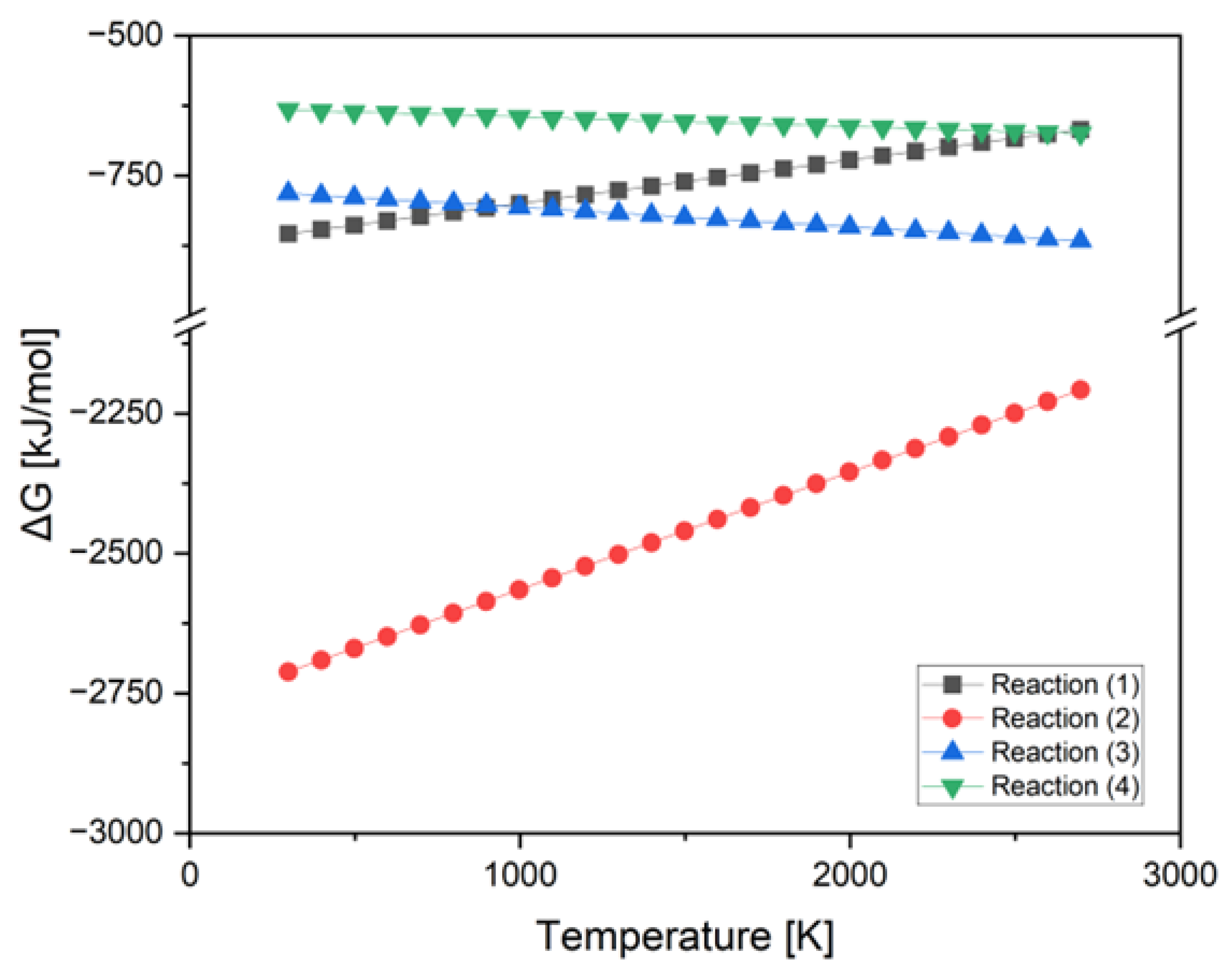
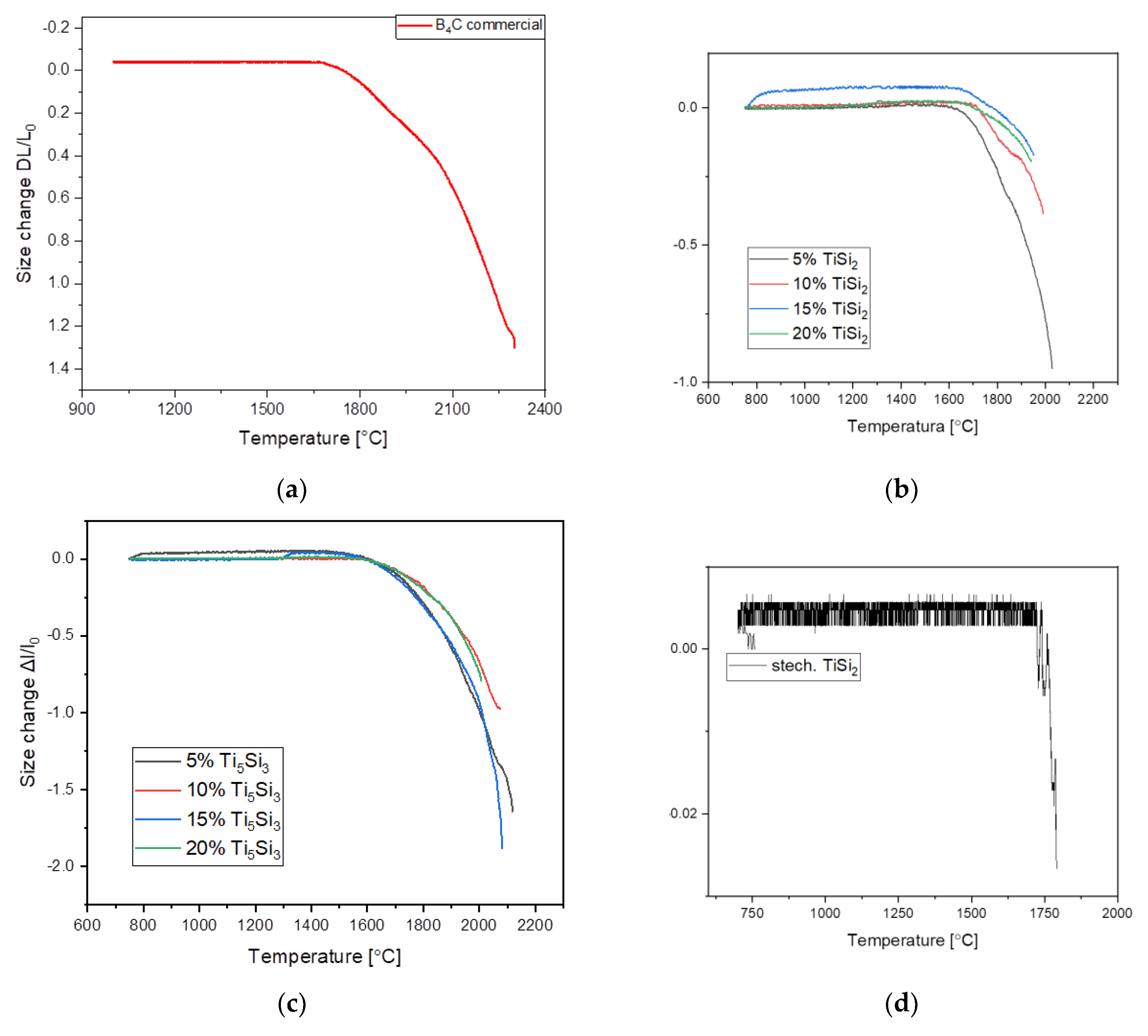
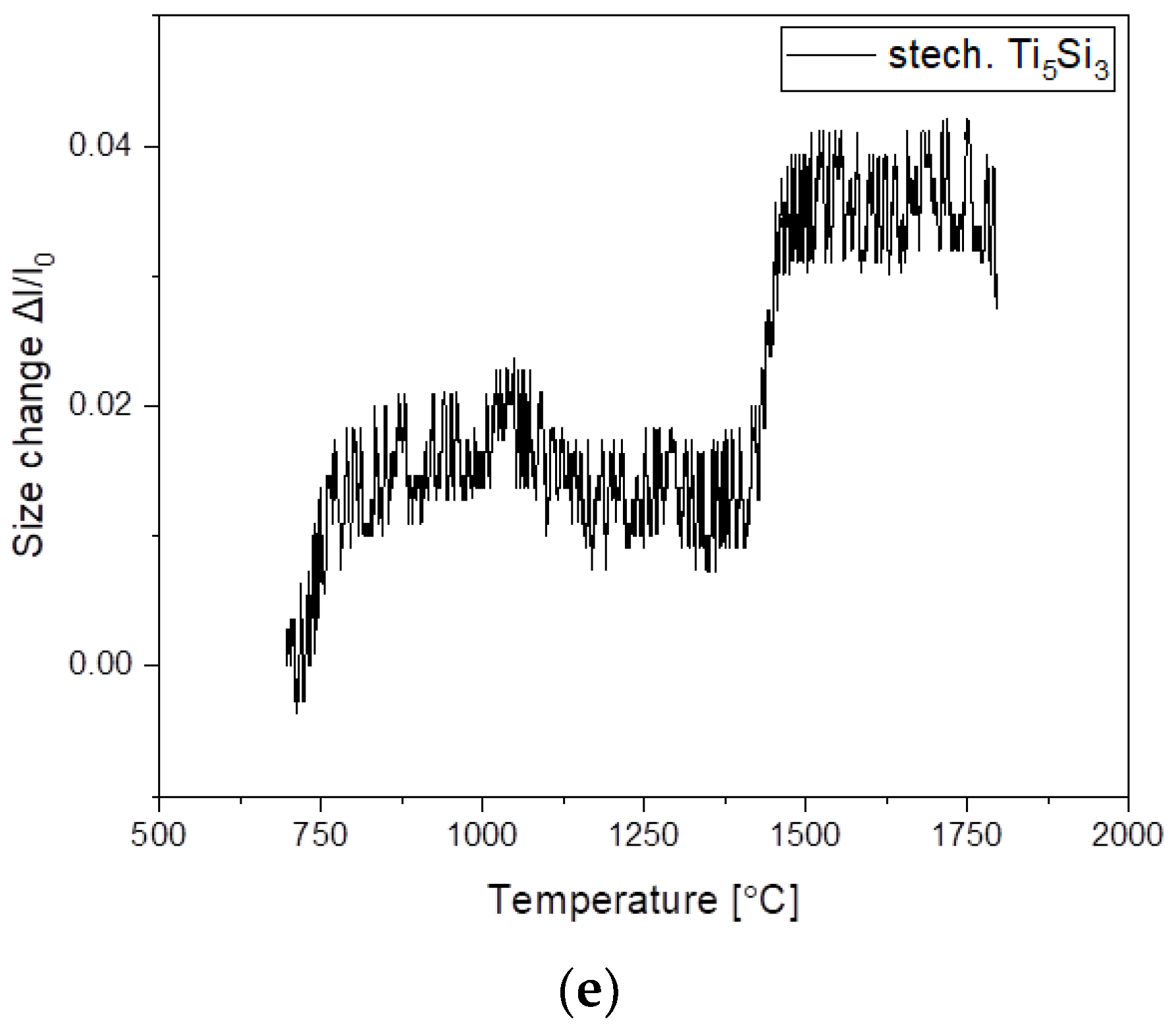
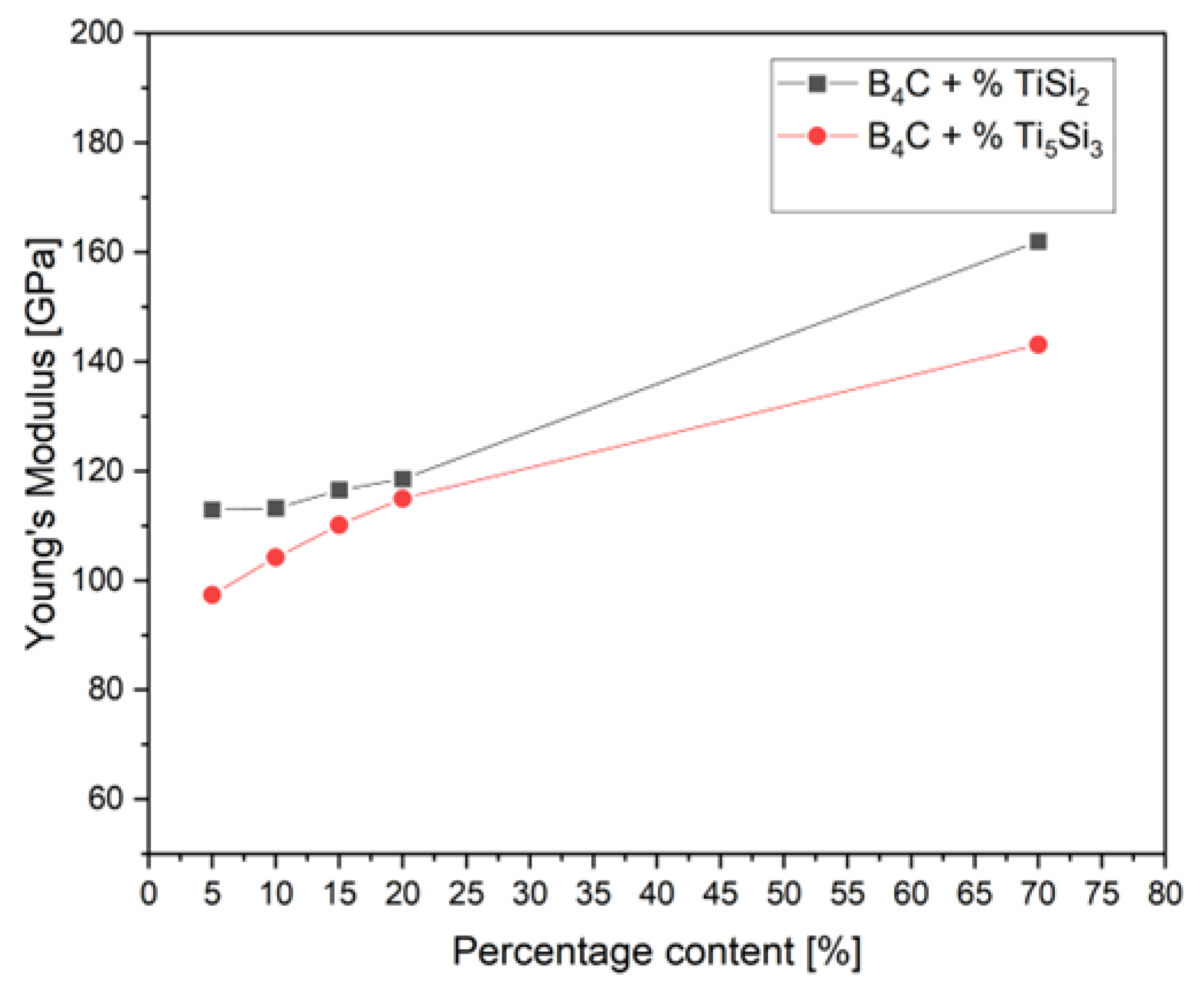
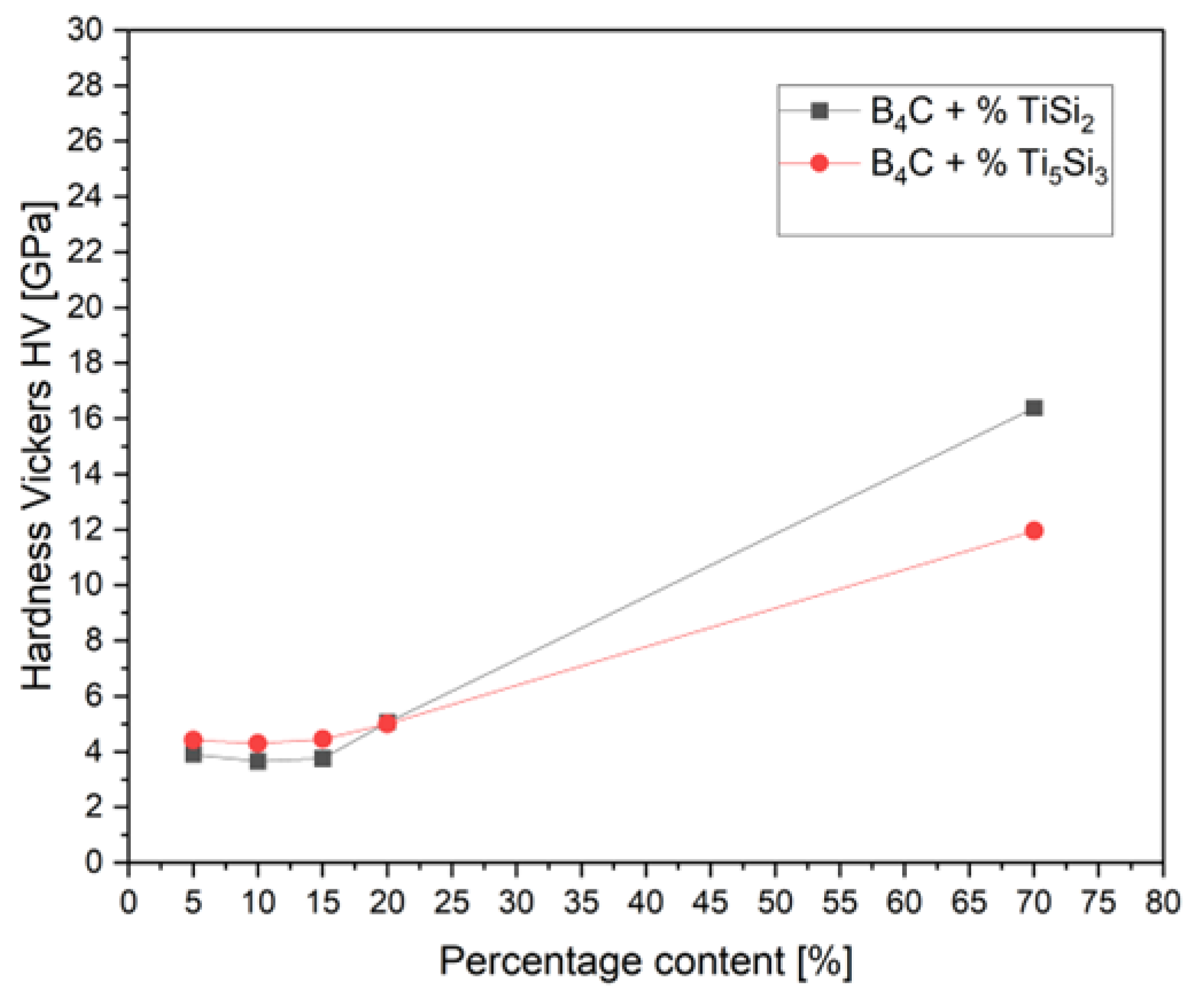
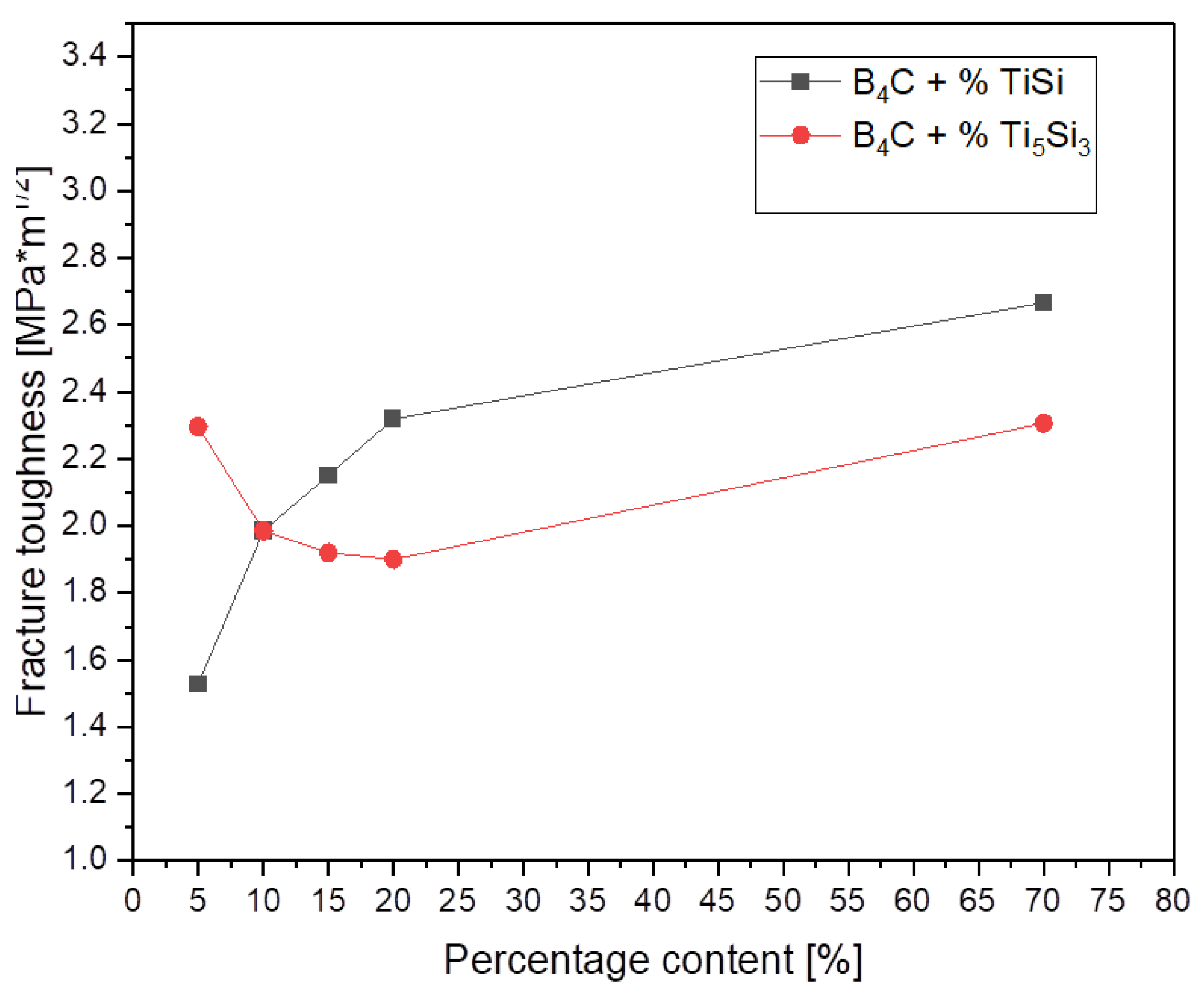
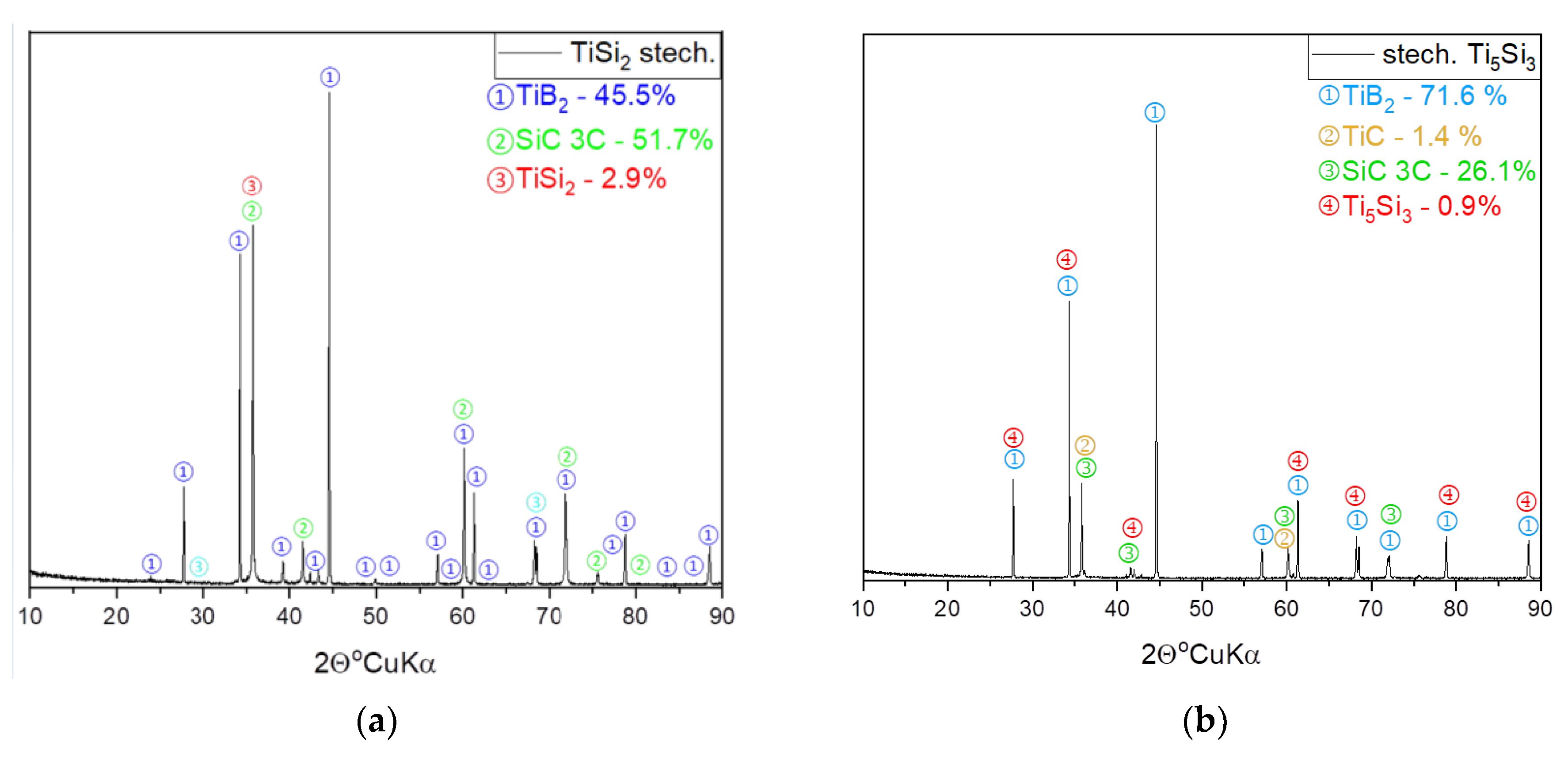
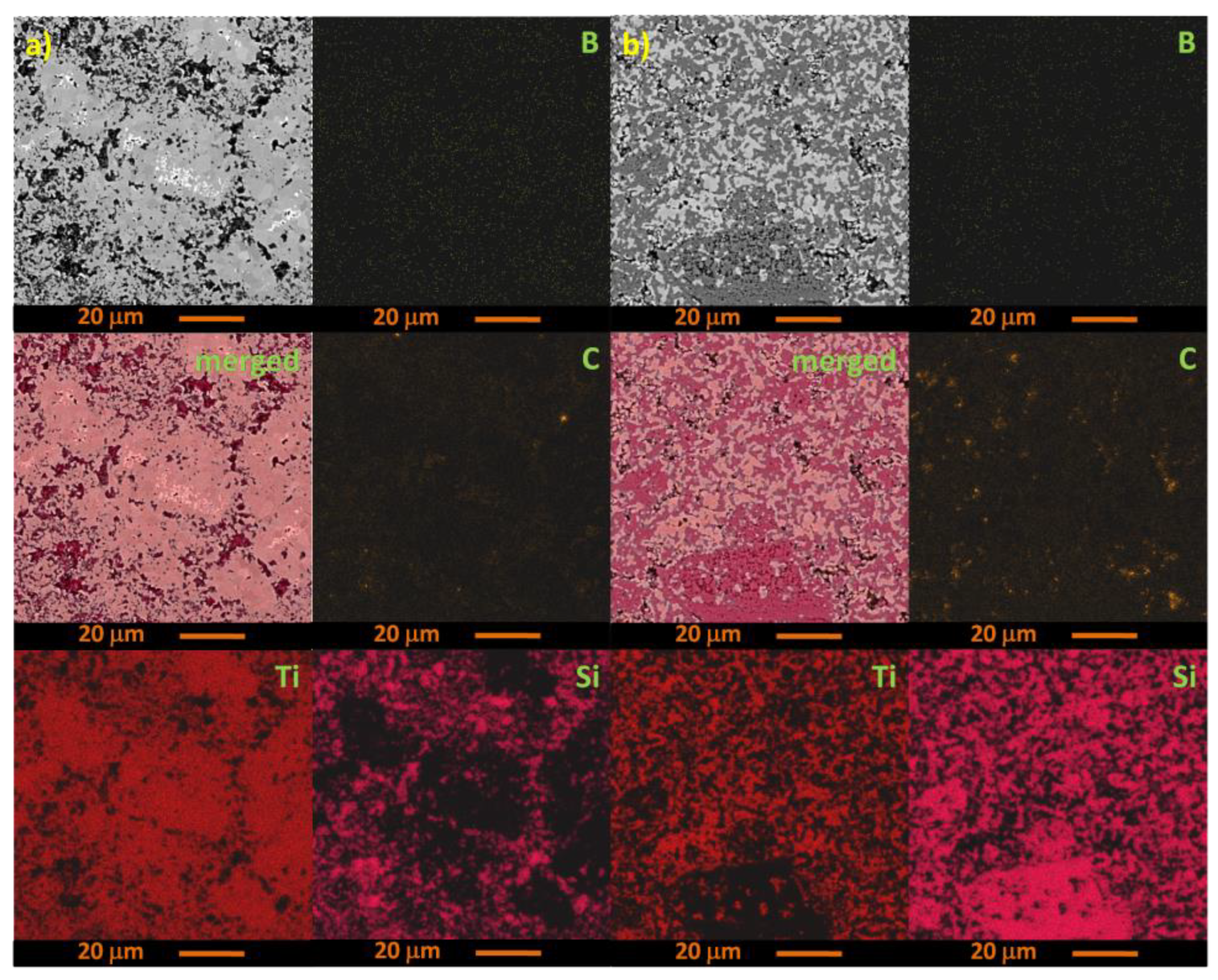

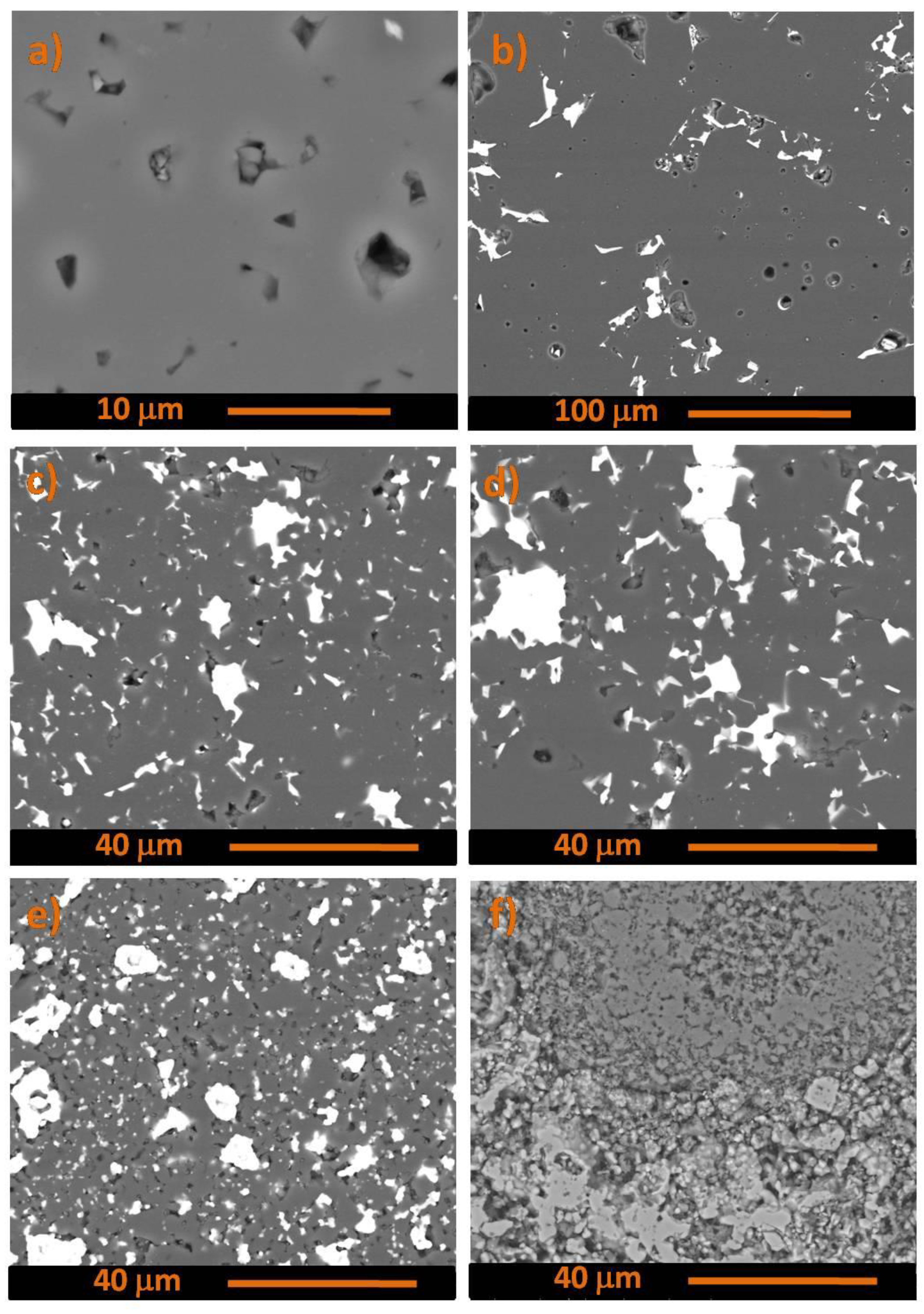
| Sample | Apparent Density [g/cm3] | Porosity [%] | ||
|---|---|---|---|---|
| Sintering at 2250 °C | Hot-Pressing at 1850 °C | Sintering at 2250 °C | Hot-Pressing at 1850 °C | |
| B4Ccom | 2.37 | 2.45 | 1.65 | 0.05 |
| B4C + 5% TiSi2 | 2.12 | 2.31 | 3.41 | 1.46 |
| B4C + 10% TiSi2 | 2.26 | 2.52 | 17.83 | 6.63 |
| B4C + 15% TiSi2 | 2.29 | 2.51 | 23.81 | 7.02 |
| B4C + 20% TiSi2 | 2.35 | 2.59 | 25.59 | 4.58 |
| B4C + 5% Ti5Si3 | 2.28 | 2.46 | 13.33 | 1.00 |
| B4C + 10% Ti5Si3 | 2.33 | 2.51 | 13.56 | 0.21 |
| B4C + 15% Ti5Si3 | 2.47 | 2.54 | 16.96 | 0.53 |
| B4C + 20% Ti5Si3 | 2.58 | 2.63 | 17.86 | 2.06 |
| B4C + 69.635% TiSi2 | 2.51 | 3.86 | 33.08 | 2.40 |
| B4C + 69.344% Ti5Si3 | 3.46 | 3.70 | 35.92 | 5.86 |
| Precursor | Composition [%] | |||
|---|---|---|---|---|
| B13C2 | Graphite [C] | TiB2 | SiC | |
| B4C commercial | 99.0 | 1.0 | - | - |
| B4C + 5% TiSi2 | 93.3 | 0.4 | 4.7 | 1.7 |
| B4C + 10% TiSi2 | 92.9 | 0.1 | 5.1 | 1.9 |
| B4C + 15% TiSi2 | 86.0 | 0.3 | 7.6 | 6.1 |
| B4C + 20% TiSi2 | 78.0 | - | 13.0 | 9.0 |
| B4C + 5% Ti5Si3 | 86.4 | 1.5 | 11.0 | 1.1 |
| B4C + 10% Ti5Si3 | 76.9 | 0.2 | 18.5 | 4.3 |
| B4C + 15% Ti5Si3 | 77.3 | 6.6 | 13.4 | 2.6 |
| B4C + 20% Ti5Si3 | 78.6 | 0.2 | 20.5 | 0.8 |
| B4C + 69.635% TiSi2 * | - | - | 45.5 | 51.7 |
| B4C + 69.344% Ti5Si3 * | - | - | 71.6 | 26.1 |
Publisher’s Note: MDPI stays neutral with regard to jurisdictional claims in published maps and institutional affiliations. |
© 2022 by the authors. Licensee MDPI, Basel, Switzerland. This article is an open access article distributed under the terms and conditions of the Creative Commons Attribution (CC BY) license (https://creativecommons.org/licenses/by/4.0/).
Share and Cite
Kozień, D.; Czekaj, I.; Gancarz, P.; Ziąbka, M.; Wieczorek, W.; Pasiut, K.; Zientara, D.; Pędzich, Z. Ceramic Matrix Composites Obtained by the Reactive Sintering of Boron Carbide with Intermetallic Compounds from the Ti-Si System. Materials 2022, 15, 8657. https://doi.org/10.3390/ma15238657
Kozień D, Czekaj I, Gancarz P, Ziąbka M, Wieczorek W, Pasiut K, Zientara D, Pędzich Z. Ceramic Matrix Composites Obtained by the Reactive Sintering of Boron Carbide with Intermetallic Compounds from the Ti-Si System. Materials. 2022; 15(23):8657. https://doi.org/10.3390/ma15238657
Chicago/Turabian StyleKozień, Dawid, Izabella Czekaj, Patrycja Gancarz, Magdalena Ziąbka, Wojciech Wieczorek, Katarzyna Pasiut, Dariusz Zientara, and Zbigniew Pędzich. 2022. "Ceramic Matrix Composites Obtained by the Reactive Sintering of Boron Carbide with Intermetallic Compounds from the Ti-Si System" Materials 15, no. 23: 8657. https://doi.org/10.3390/ma15238657







